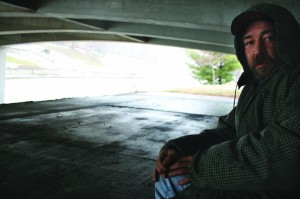Waking up, Steve Johnson stretches his legs and arms and feels the stress in his back from sleeping on pavement all night. He opens his eyes to first see the cloud of his icy breath, and then a white, frozen Brush Creek only a few yards away. Immediately, Johnson feels the numbing  degree cold. He could escape it for a few hours of sleep under a bridge, but now he must leave his ‘home’ to bear the weather. He inches up the steep incline, trying not to slip on the ice, and emerges from the bridge that covered his head to see the snow that covered Kansas City.

For the students of STA, snowfall and subzero windchill temperatures meant two days off of school in the beginning of January. But for Johnson, and the homeless across the city, it meant a fight to stay alive.
Part of Johnson’s fight means holding up a sign on a Plaza street corner, hoping for donations to supplement his small social security check. He is ashamed to be where he is, and pleads for pity.
‘When you go back to school, tell your teacher that someone you met is doing the best he can, and he can’t afford to be anywhere different than outside sometimes,’Â Johnson said.
Wintry worries
According to a report by reStart, a homeless shelter at 9th and Harrison, Johnson is one of Kansas City’s 13,000 homeless that struggle against the brutal cold of winter without permanent shelter.
During the winter, especially, the homeless depend on social services and charity to survive. ReStart is one of Kansas City’s homeless shelters that provides structure for many families, including 3 meals a day, therapy, substance abuse support groups, and warmth to ‘anyone who needs somewhere to sleep,’Â according to reStart’s director of development Karis Erwin.
ReStart’s lenient requirements for admission are especially important during the winter.
‘One of the things we did when it got really cold is that over the weekends when the day shelter isn’t open, we let emergency shelter guests stay from Friday to Sunday so that they don’t have to be sent out in the cold weather when it’s freezing cold and they have nowhere to go,’Â Erwin said.
She also said community efforts to counteract the cold have been tremendous.
‘When the temperatures were below zero, we had truckloads of people pulling up with blankets and coats,’Â Erwin said. ‘One woman came with 100 brand new coats. One girl, who was maybe 15, spent 2 months crocheting hats and scarves for residents.’Â
While donations help ease the cold’s physical damage to the homeless, shelter employees need help to ease the emotional toll that their job takes on them.
‘I think with the snow and the winter weather coming around the holidays, which is a time of stress for folks anyway, it really kind of increased peoples’ stress,’ reStart’s executive director Evie Craig said. ‘We were obviously very busy and we were putting in heaters all over the place and places were expanding their capacity, but we were also just dealing with staff burnout. We had people stretched so thin’¦About another week and we would have been in a very bad situation.’Â
Luckily for Craig and her employees, the temperatures have risen and many shelters are still serving Kansas City’s homeless.
A story of recovery: reStart was first a place a refuge for Patrick Jones and his family, but now it’s a place of employment
At reStart, a homeless shelter in Kansas City at 9th and Harrison, there are many employees who notice the effects of the cold on the residents they host. But there is one employee who has a much closer connection to those he helps.
Receptionist Patrick Jones, 21, was once homeless and turned to reStart for support. He moved into reStart’s 30-day emergency program with his family when he was 14 years old, and stayed for the two-year maximum transitional housing. According to Jones, his parents lost their house and they needed somewhere to take their children.
Although he was young, Jones said he knew how much his family was struggling.
‘I understood the situation,’Â Jones said. ‘But it was alright with me. It wasn’t nothing new to me.’Â
Jones praises reStart and says it prepared his family to remain in permanent housing after they left. Jones’ family is part of the 65 percent of residents in the transitional living program who go on to live in permanent housing for 12 months or longer.
Jones thinks there is a risk of the homeless becoming dependent on shelters’ services, but he found that reStart did not cause this problem for his family.
‘I considered myself somewhat homeless,’Â Jones said. ‘I was homeless for a little while because then it turned around, and my momma started working, and she was actually paying to stay [at reStart.]’Â
But before Jones’ family found security, he found that living in a shelter did affect him emotionally.
‘The hardest part was wondering if you’re gonna have to stay here forever,’Â Jones said.
Jones has been living an apartment for two years and has no doubt that he can keep a roof over his head. He just might change the location of that roof to somewhere like Florida.
‘It’s warmer there,’Â Jones said.
Dangers of the cold
While cold weather ushers increased donations, it also brings to light the question of why so many remain on the streets during dangerous temperatures.
According to the National Mental Health Information Center, 25 percent of homeless people have a serious mental illness, which affects their ability to keep a job, permanent housing, or to even find a shelter. Anyone above the age of 18 can not be admitted to a psychiatric unit against their will according to a judicial mandate, so they often remain living on the street, even in record cold temperatures.
Johnson admitted that he suffers from schizophrenia and that he does not sleep in shelters available to the public. He said he sometimes sleeps under the bridges of Brush Creek, but that he has recently been sleeping on a porch.
While some programs such as Swope Health Services and Truman Medical Center have outreach programs to bring the homeless indoors, Craig said that she can’t ‘force people to come inside.’Â However, reStart employees notice that severe weather conditions cause those who would usually stay outside to knock on reStart’s doors. The shelter can host 310 overnight guests at full capacity, and they have done so multiple times this winter.
Many homeless people are on the steps to recovery, including the 65 percent of those that stay in permanent housing for a year or more after leaving reStart. But there are still those, like Johnson, who live day to day. Snow storm to snow storm. Breath to breath.









